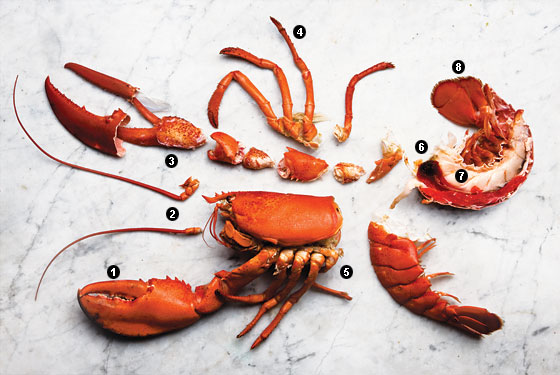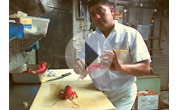
1. The Claws
Separate the arms from the body. Hyperextend the lobster’s “thumb”and pull it off. Use a cracker or knife (or your hands) to break the shell, and pull out the meat with a fork. Because of the rubber bands placed around lobsters’ claws in tanks, the claw meat may have atrophied (a sign of a not-so-fresh lobster). The claw meat should be nearly as large as the shell around it.
2. The Head and Thorax
Additional meat can be found toward the front of the body cavity. Peel off the outer shell, split the body down the middle with your thumbs, and pick it apart (either with a fork or with your fingers).
3. The Knuckles
The connections between the claw and the body have sweet meat inside of them. Use a cracker or knife to break them into pieces and push the meat with a small fork.
4. The Walking Legs
When eating a whole lobster, you can break off the six small legs, separate them into sections, and suck the meat as through a straw. You can also press down on the legs with your fingers, moving from the ends toward the body.
5. The Tomalley
The light-green tomalley found inside the main body of the lobster is its liver and pancreas. The taste is rich, and while it can be eaten alone, many people like to mix it with bread crumbs to make a stuffing.
6. The Blood
A lobster’s blood is clear when the animal is living and turns into an opaque white gel when cooked. You’ll find this throughout the claws and body. It’s bland, but definitely edible.
7. The Roe
The roe (unfertilized eggs) in the body of a female lobster is dark green when raw, but turns bright red when cooked. It is tasty on its own, but is also used in sauces, bisques, and stocks.
8. The Tail
Pinch near the top of the tail and twist to pull it from the body. Either split the tail down the center with a knife or squeeze the edges of the tail shell together and then pull them apart, snapping the shell. The tail meat can then be removed in one piece. Pull off the sections of the tail fan at the tip for small bits of extra meat.
The Ultimate Boat Snack
Mermaid Inn chef Jose Luis Martinez suggests a lobster-sandwich recipe that should be prepared in advance and eaten onboard your skiff. Makes 6 sandwiches.
6 2-pound lobsters
1 small red onion, finely diced
4 stalks celery, finely diced
12 sprigs chive
6 tablespoons lemon juice
2 cups mayonnaise
Salt and pepper
6 brioche sandwich rolls
6 tablespoons melted butter
Chop the meat into ¼-inch sections and place in a large bowl. Add the finely chopped onion, celery, chives, and lemon juice to the bowl with the lobster meat. Add mayonnaise and salt and pepper to taste.
Cut each brioche roll in half and lightly brush butter on both halves. On a griddle, place the buns buttered side down and cook until they are golden brown. Take off the griddle and place about 7 ounces of lobster salad on the roll.
Pick (and Then Cook) a Good One
Buying
“When they pull it out of the water, its tail should be flapping,” says Brendan Hayes, retail director of the Lobster Place. “If it’s limp, that’s a sign of a soon-to-be-dead lobster.” A lobster with a softer shell has recently molted and is likely to have more water weight and less meat. Cook within 24 hours of purchase.
Cooking
While it’s popular to boil lobsters, steaming with a small amount of salt water helps retain juice and flavor. Put about an inch of water in a covered pot, adding 2 tablespoons of salt for every quart, bring to a rolling boil, and place the lobsters in. A 1½-pound lobster should cook for about 15 minutes, while a 4-to-5 pounder should cook for 22 to 24 minutes, at which point the body will be bright red.

Jose Luis Martinez shows how to extract the most lobster meat.